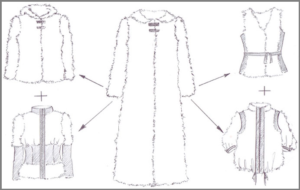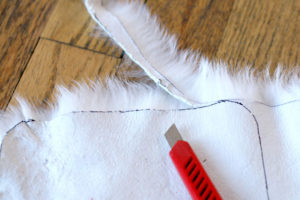 A fur coat, like any other item of clothing, can become old, lose its “marketable appearance” or simply go out of fashion. However, this does not mean that it loses its relevance and needs to be thrown away. Today we will look at several ideas for updating a fur coat and discuss some of the secrets and features of this topic!
A fur coat, like any other item of clothing, can become old, lose its “marketable appearance” or simply go out of fashion. However, this does not mean that it loses its relevance and needs to be thrown away. Today we will look at several ideas for updating a fur coat and discuss some of the secrets and features of this topic!
What is needed to transform an old fur coat into a “new” one?
Regardless of the type of fur coat, you will need a certain, standard set of tools - these are:
- Sharp knife. A knife with a retractable blade can be used (but not a stationery knife). It is recommended to use special knives for cutting fabrics.
- Tweezers. You can use any tweezers. This tool will be used rarely, however, its presence is necessary.
- A set of strong threads. Cotton threads will be the best solution. If you have a more unique fur coat renovation project, you can use silk threads and others.
- Set of needles. Be sure to have a needle for leather goods and a thimble.
 It is also recommended to decide in advance on the pattern of the future project. On the Internet you can find many pattern options to suit your needs and taste preferences. If your sewing experience allows, you can take on the process of developing a pattern yourself, which will make the fur coat a unique and unrepeatable item.
It is also recommended to decide in advance on the pattern of the future project. On the Internet you can find many pattern options to suit your needs and taste preferences. If your sewing experience allows, you can take on the process of developing a pattern yourself, which will make the fur coat a unique and unrepeatable item.
Ideas on how to remake an old fur coat
 Let's consider a few ideas for future work that should suit your taste.
Let's consider a few ideas for future work that should suit your taste.
Fashionable vest made from an old fur coat
Usually the most worn part of any item is the sleeves. This also applies to fur coats. Why not ditch the worn sleeves and make a warm, stylish vest?
 In order to rip out the seams near the sleeve sewing line, you will need a knife. Start by making neat cuts in the thread and work your way along the sewing line. After completing this step, sew the previous joints with new seams. With these actions you will prevent the entire fur coat from falling apart at the seams and add aesthetics to the overall design.
In order to rip out the seams near the sleeve sewing line, you will need a knife. Start by making neat cuts in the thread and work your way along the sewing line. After completing this step, sew the previous joints with new seams. With these actions you will prevent the entire fur coat from falling apart at the seams and add aesthetics to the overall design.
If the volume of the body of the fur coat is greater than the volume of the chest circumference, you can sew in the remaining fabrics and decorate them as part of the overall design. It is good to hide the suturing with the help of old sleeves, or with the help of strips or overlays.
Fur coat with stripes
Stripes can be:
- solid;
- spiral;
- “torn”.
Stripes look harmonious with almost any type of clothing.
 You can use both fur stripes and stripes made from various synthetic fabrics. The end result will be able to hide old scuffs and make your appearance charismatic and modern - now it is in fashion to look bright and attract attention.
You can use both fur stripes and stripes made from various synthetic fabrics. The end result will be able to hide old scuffs and make your appearance charismatic and modern - now it is in fashion to look bright and attract attention.
Fur coat using inserts
 You can “refresh” the overall look with the help of unusual, original inserts from a different type of fur.It is best to use lightweight inserts made of durable materials.
You can “refresh” the overall look with the help of unusual, original inserts from a different type of fur.It is best to use lightweight inserts made of durable materials.
The inserts can also be used as hidden pockets and hiding places, which can be useful in emergency situations or to save space in your pockets. The insert can have either a chaotic or a geometrically correct shape.
 Inserts made of longer fur than the length of the base fur of the fur coat look original. This design move will attract increased attention to you and make you stand out in photos with friends.
Inserts made of longer fur than the length of the base fur of the fur coat look original. This design move will attract increased attention to you and make you stand out in photos with friends.
Before sewing on the inserts, it is necessary to stitch their outer part to avoid sections and add greater aesthetics. Sewing is best done with a sewing machine, which will speed up the process and make the seams more neat. Handmade will require more time, but can be used as part of the design.
Features of working with fur coats
 Fur is very difficult to alter. You need to know a few secrets that will help make working with it faster and more efficient:
Fur is very difficult to alter. You need to know a few secrets that will help make working with it faster and more efficient:
- Cut the fur only from the inside. This way you can avoid losing fibers near the incision sites. If the lining is leather (this also happens in more expensive models), you must use special knives and needles.
On a note!
You can make an additional wardrobe item from leftover fur. It could be a hat, gloves or a mobile phone case - experiment!
- If you plan to use glue in your work, it is better to purchase its solvent in advance. If you accidentally spill a few drops of glue, you can immediately remove it without leaving a trace. Sometimes when working with glue, it is recommended to wet the fur with water so that it sticks together into a “common lump” and makes it easier to work with.
- It is better to stitch the seams with decorative stitches.This will once again add strength to the product and be able to hide the joints.
Work with sewing tools with extreme caution, and then your hands, as well as the product, will remain safe and sound.


 0
0






Yeah, with lessons like these, will all the fur coats end up in a landfill?
Where did you find such words - “place of sewing”??? this is called stitching, and fur coats are assembled not with decorative stitching, but at a furrier or by hand.